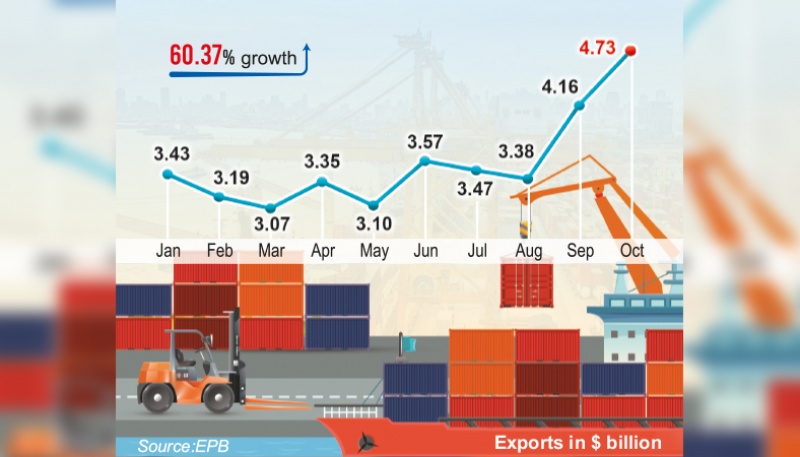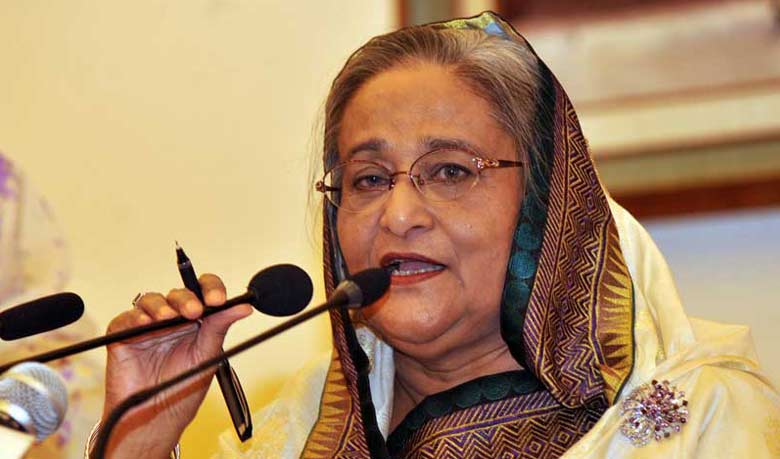Staff Correspondent
Published:2021-11-03 21:21:54 BdST
Exports hit all-time high at $4.73b in October
Bangladesh posted a robust $4.73 billion in export earnings this October – the highest ever recorded in a single month, backed by the rising demand for mainly apparel products in reopening global economies, especially the European Union and United States.
Of the total export earnings, $3.56 billion came from clothing products, helping the country register a sharp growth and showing a strong sign of recovery from the Covid-19 pandemic fallout.
The Export Promotion Bureau (EPB) data shows that Bangladesh’s exports grew by 60.37 percent in October compared to the same period last year. In October 2020, Bangladesh exported goods worth $2.95 billion.
Bangladesh, during the July-October period of the current fiscal, earned $15.75 billion through exports, which was 22.62 per cent higher compared to $12.84 billion recorded in the same period last year.
EPB data shows that every sector recorded positive growth except the jute, jute goods and building materials sector.
Zahid Hussain, a former lead economist of World Bank, Bangladesh told The Business Post, “Global economic recovery, especially in the US – the single largest export destination of Bangladesh, has created the demand for clothing products.
“To cater to this demand, buyers placed more work orders. Besides, Bangladesh also benefited from relocation of work orders from Myanmar, which is now under military rule and has been put under global sanctions.”
At the same time, the Covid-19 situation worsened in Vietnam and Cambodia which compelled them to follow strict health safety guidelines, he added.
Apparel sector earnings $12.62b in Jul-Oct
In July-October 2021, $12.62 billion export earnings came from the apparel sector, and the year-on-year export growth was 20.78 per cent, compared to $11.22 billion in 2020, according to the EPB.
During the same period this year, the knitwear sector earned $7.21 billion with $24.27 per cent growth, and the woven sector earned 5.41 billion with 16.41 per cent growth.
The home textile sector however failed to meet its export target, but continued its positive growth. This sector earned $412 million with 16.52 per cent growth compared to the same period previous year, but fell short by 5.69 per cent from target.
In July-October 2020, the home textile sector had earned $354 million.
Faruque Hassan, president of Bangladesh Garment Manufacturers and Exporters Association, said, “After the Covid-19 situation eased, global retailers placed more work orders. We now have a large volume of orders and the buyers are giving us pretty good prices.
“This has helped us increase our export volume and worth. Prices of raw materials, including accessories and fabrics, and freight charges have increased sharply. Coupled with the rise in raw material price, unit prices of clothing products have risen too.”
President of Bangladesh Garment Buying House Association Kazi Iftekhar Hossain said this growth may continue till 2022.
“Our export is mostly dependent on the readymade garments sector and most of the factories are making cotton products. This is a matter of concern. To continue this export growth, we need to diversify our products and set up more factories based on manmade fibre,” he added.
During July-October 2021, export earnings from the leather and leather goods sector rose 28.85 per cent year-on-year to $364.9 million. It is 10.79 per cent higher compared to their target. In the same time previous year, the leather and leather goods sector earned $283.2 million.
Among other major sectors, agricultural products have posted a 26.34 per cent positive growth to $464 million, against $358.82 million earned during the same period in 2020.
Export earnings from the pharmaceuticals sector rose by 31.60 per cent to $73.88 million, while earnings from plastic goods grew by 29.04 per cent to $46 million.
In July-October 2021, export earnings from the frozen and live fish increased 17.46 per cent. This sector earned $225 million, which was $191.75 million in the same period previous year.
Meanwhile, the jute and jute goods sector continuously performed negative growth since April 2021. From July to October 2021, this sector earned $333 million with 24.11 per cent negative growth compared to the same period previous year.
In July to October 2020, the jute and jute goods sector earned $438.78 million.
Industry insiders said due to low demand in the international market and high price of raw jute in the domestic market, this sector is failing to perform.
Director of the Bangladesh Jute Goods Exporters Association and CEO of Tulika, Esrat Jahan said, “Till now, we have been exporting basic items such as sacks and yarn. But we need to diversify our products.
“Bangladesh does not hold international expos to attract buyers, and most of the entrepreneurs capable of diversifying jute goods are from the cottage industry. It is very difficult for them to attend fairs taking place abroad, especially in the US and EU.”
Unauthorized use or reproduction of The Finance Today content for commercial purposes is strictly prohibited.









